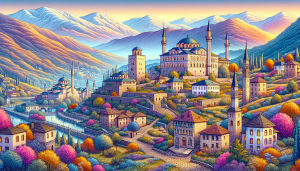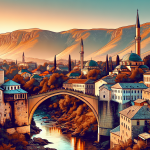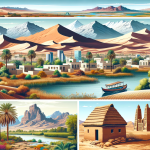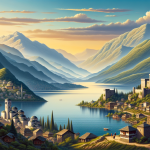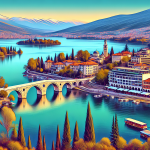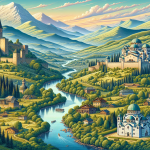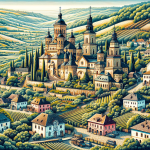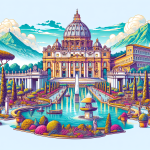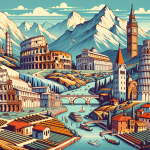A Comprehensive Travel Guide to Kosovo: The Hidden Gem of the Balkans
Nestled in the heart of the Balkans, **Kosovo** is a destination that often flies under the radar for many travelers. However, this relatively young country, which declared its independence from Serbia in 2008, is a treasure trove of history, culture, and natural beauty. With its rich tapestry of medieval architecture, vibrant cities, and stunning landscapes, Kosovo offers a unique travel experience that combines the old with the new. This comprehensive travel guide will delve into the best places to visit, things to do, and essential travel tips for making the most out of your trip to Kosovo. Whether you’re a history buff, a nature enthusiast, or someone simply looking to explore an off-the-beaten-path destination, Kosovo has something for everyone. So, let’s embark on a journey to discover the hidden gem of the Balkans.
Exploring Pristina: The Capital City
Pristina, the capital city of Kosovo, is often the starting point for many travelers. This bustling city is a mix of old and new, where historic landmarks stand side-by-side with modern architecture. One of the must-visit places in Pristina is the **Newborn Monument**, a symbol of the country’s independence. This monument is repainted every year, reflecting the ever-changing spirit of Kosovo. Another significant site is the **National Library of Kosovo**, known for its unique and controversial design. The library’s architecture is a topic of much debate, but it undoubtedly stands as a symbol of the country’s commitment to education and culture.
Historical Sites
Pristina is home to several historical sites that provide a glimpse into the country’s past. The **Ethnological Museum**, housed in an 18th-century complex, offers a fascinating look at the traditional way of life in Kosovo. Here, you can explore various exhibits showcasing traditional clothing, tools, and household items. Another noteworthy site is the **Gračanica Monastery**, a UNESCO World Heritage site located just a short drive from the city center. This Serbian Orthodox monastery, built in the 14th century, is renowned for its beautiful frescoes and well-preserved architecture.
Modern Attractions
For those interested in contemporary culture, Pristina has a vibrant arts and entertainment scene. The city hosts several art galleries, theaters, and music venues. The **National Gallery of Kosovo** is a great place to explore contemporary Kosovar art, while the **Dodona Theater** offers a range of performances, from classic plays to modern productions. Additionally, Pristina’s nightlife is lively, with numerous bars, clubs, and restaurants offering a taste of the local culture. Don’t miss the chance to try traditional Kosovar cuisine, which features a mix of Balkan and Mediterranean influences.
Discovering Prizren: The Cultural Capital
Prizren, often referred to as the cultural capital of Kosovo, is a city that exudes charm and history. Nestled at the foot of the Šar Mountains, Prizren is known for its well-preserved Ottoman-era architecture and vibrant cultural scene. The city’s picturesque old town is a maze of cobblestone streets, historic buildings, and bustling markets. One of the most iconic landmarks in Prizren is the **Sinan Pasha Mosque**, a stunning example of Ottoman architecture. Built in the early 17th century, the mosque features intricate designs and offers panoramic views of the city from its courtyard.
Historic Landmarks
Prizren is home to several historic landmarks that are well worth a visit. The **Prizren Fortress**, also known as Kalaja, is a must-see. This ancient fortress, perched on a hill overlooking the city, offers breathtaking views and a glimpse into Prizren’s past. The fortress dates back to Roman times and has been used by various civilizations throughout history. Another significant site is the **Church of Our Lady of Ljeviš**, a UNESCO World Heritage site that dates back to the 14th century. This Serbian Orthodox church is renowned for its beautiful frescoes and historical significance.
Cultural Events
Prizren is also known for its vibrant cultural events and festivals. The **Dokufest International Documentary and Short Film Festival**, held annually in August, is one of the most significant cultural events in Kosovo. This festival attracts filmmakers and cinephiles from around the world and offers a platform for showcasing thought-provoking documentaries and short films. Additionally, the city hosts various music festivals, art exhibitions, and traditional celebrations throughout the year, making it a lively and dynamic destination.
Exploring the Natural Beauty of Kosovo
Beyond its cities, Kosovo boasts stunning natural landscapes that are perfect for outdoor enthusiasts. From lush forests and rolling hills to serene lakes and rugged mountains, the country’s diverse terrain offers a range of activities for nature lovers.
Rugova Canyon
One of the most popular natural attractions in Kosovo is the **Rugova Canyon**, located near the city of Peja. This spectacular canyon stretches for over 25 kilometers and is one of the deepest in Europe. Visitors can enjoy a range of activities here, including hiking, rock climbing, and even zip-lining. The canyon is also home to several caves, such as the **Rugova Cave**, which offers a fascinating underground adventure. For those seeking a more leisurely experience, the canyon’s scenic routes provide breathtaking views and excellent opportunities for photography.
Brezovica Ski Resort
For winter sports enthusiasts, the **Brezovica Ski Resort** is a must-visit destination. Located in the Šar Mountains, this resort offers excellent skiing and snowboarding opportunities. With its well-groomed slopes and stunning alpine scenery, Brezovica is a popular spot for both locals and tourists. The resort caters to all skill levels, from beginners to advanced skiers, and offers various amenities, including equipment rentals and ski schools. In addition to winter sports, Brezovica is also a great destination for hiking and mountain biking during the summer months.
Understanding Kosovo’s Rich History
Kosovo’s history is a complex tapestry woven with various influences from different civilizations. Understanding this history enriches the travel experience, offering deeper insights into the country’s culture and identity.
Medieval Period
The medieval period is one of the most significant eras in Kosovo’s history. During this time, Kosovo was a prominent center of the Serbian Empire. Many of the country’s most famous historical sites, such as the Gračanica Monastery and the Church of Our Lady of Ljeviš, date back to this period. These sites are not only architectural masterpieces but also bear witness to the rich cultural and religious heritage of the region.
Ottoman Influence
The Ottoman Empire ruled Kosovo for over 500 years, leaving a lasting impact on the region’s culture, architecture, and traditions. The city of Prizren, in particular, showcases this influence through its well-preserved Ottoman-era buildings and mosques. The Sinan Pasha Mosque and the historic **Hammam of Prizren** are prime examples of Ottoman architectural and cultural legacy. The Ottoman period also introduced various culinary traditions and customs that are still evident in Kosovar culture today.
Modern History
In the 20th century, Kosovo experienced significant political and social changes. Following World War II, Kosovo became an autonomous province within Yugoslavia. However, the late 20th century brought conflict and turmoil, culminating in the Kosovo War of 1998-1999. The war had a profound impact on the country and its people, leading to a humanitarian crisis and significant loss of life. In 2008, Kosovo declared its independence from Serbia, a move that has been recognized by over 100 countries. Today, Kosovo is focused on rebuilding and developing its economy, infrastructure, and international relations.
Practical Travel Tips for Visiting Kosovo
Traveling to Kosovo requires some preparation, especially for first-time visitors. Here are some practical tips to help you make the most of your trip:
- **Visa Requirements:** Most visitors from the EU, US, and several other countries can enter Kosovo without a visa for stays of up to 90 days. However, it’s always best to check the latest visa requirements before your trip.
- **Currency:** The official currency of Kosovo is the Euro (€). ATMs are widely available in cities, and credit cards are accepted in most establishments.
- **Language:** The official languages are Albanian and Serbian. English is widely spoken in urban areas, especially among the younger population.
- **Transportation:** Public transportation is available, but renting a car can provide more flexibility for exploring the country. Roads are generally in good condition, but be prepared for some mountainous terrain.
- **Safety:** Kosovo is generally safe for tourists, but it’s always wise to stay informed about the current political situation and exercise common travel precautions.
Conclusion
Kosovo is a destination that offers a rich and diverse travel experience. From the bustling streets of Pristina and the historical charm of Prizren to the breathtaking natural landscapes of Rugova Canyon and Brezovica, there’s something for everyone in this hidden gem of the Balkans. Whether you’re interested in exploring the country’s rich history, immersing yourself in its vibrant culture, or simply enjoying the stunning scenery, Kosovo is sure to leave a lasting impression. So, pack your bags and get ready to discover all that Kosovo has to offer!
For more information on planning your trip to Kosovo, visit the official tourism website: [Visit Kosovo](https://visitkosovo.org).
